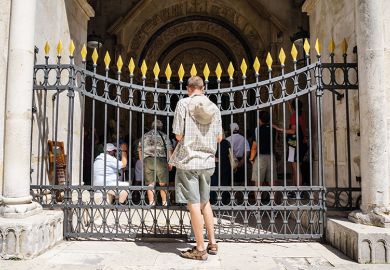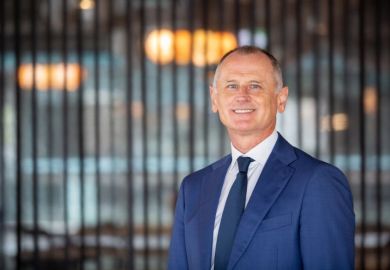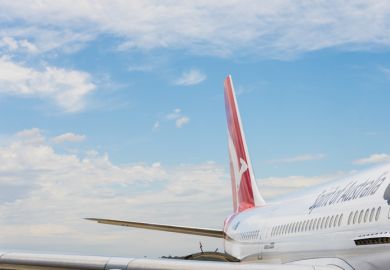Key decisions on whether or not to bar some of the biggest English for-profit colleges from accessing public student loan funding are looming, and could hinge on the number of learners leaving midway through their studies, Times Higher Education understands.
Several institutions are awaiting a final decision on whether they will be included on the Office for Students’ new register of providers, a necessary condition for their students being able to take out publicly funded loans.
THE reported in May that 20 providers had been informed that the OfS was “minded to refuse” applications to the register and earlier this month the regulator issued its first notice saying that a provider – Bloomsbury Institute Limited – had failed to meet registration conditions on two grounds: quality, and management and governance.
The OfS’ decision is said to have sparked concern among some other providers still awaiting final decisions, expected by mid-August. Any refusal decisions by the OfS could have major implications for the future of for-profit higher education in England.
One of the “core” metrics that the OfS is considering in registration applications is data on student dropout rates, such as whether a learner continues their studies after one year at an institution.
Although the OfS creates its own indicators on non-continuation, data from the Higher Education Statistics Agency show that a number of institutions that have yet to gain registration have high dropout rates.
One of the largest, GSM London, which had almost 3,000 full-time students starting a full degree course in 2016-17 and is England’s biggest for-profit recruiter of students with public loans funding, had a dropout rate for such students of 36.5 per cent, according to Hesa data. This was 12.5 percentage points higher than its “benchmark”, the level that would be expected for its mix of students, a gap that was one of the biggest in the dataset.
It was also higher than the dropout rate for full-time students at the Bloomsbury Institute, which for 2016-17 entrants was 29.3 per cent, 7.6 percentage points above its benchmark.
Another for-profit college, St Patrick’s College, had one of the biggest gaps from its benchmark for undergraduates on non-degree courses: 44.2 per cent of its 530 full-time entrants in 2016-17 had left higher education the following year against a benchmark of 27.5 per cent.
Both GSM and St Patrick’s have applied for the OfS register but, at the time of publication, neither was on the current list of 378 providers, which already includes all established universities and a large proportion of major alternative providers. Both colleges had access to loans under the previous regulatory regime.
A spokeswoman for GSM said it was “continuing to work closely with the Office for Students and we expect their final decision on our registration to be confirmed in mid-August. It would not be appropriate to comment further ahead of that decision being made.”
THE did not receive a response from St Patrick’s in time for publication.
The OfS said “while we have made decisions on a significant majority of applications, we are continuing to assess a small number of applications”.
It added that where a provider had been told that the OfS was “minded to refuse” an application, providers had an opportunity to “make representations before we finalise our decision”.
Both GSM and St Patrick’s told THE in May that they had not received a “minded to refuse” letter.
The prospect of some more institutions being excluded from the register comes as the latest National Student Survey results revealed how some large alternative providers are struggling with overall student satisfaction scores.
Among them was the University Campus of Football Business, where just under half of students (49 per cent) agreed that they were satisfied with the quality of their course against a benchmark of 82 per cent.
The NSS is not one of the core metrics used by the OfS in assessing registration applications. However, UCFB, which has previously had access to loans, is also not currently on the OfS register and had told THE in March that it intended to apply.
Brendan Flood, chairman and chief executive of UCFB, said the use until recently of Wembley stadium – one of its main campuses – by Premier League club Tottenham Hotspur had "caused significant challenges to our student experience”.
“We are investing £110 million in Wembley to develop dedicated high-quality facilities comprising 700 student beds and 50,000 square feet of academic and office accommodation. We have listened to feedback and are investing appropriately.”
Other large alternative providers with relatively low student satisfaction scores in the NSS are already on the OfS register.
However, Alex Proudfoot, chief executive of Independent Higher Education, said that although nine alternative providers had NSS ratings significantly below benchmark, this was compared with 42 publicly funded higher and further education institutions. A higher proportion of alternative providers were also significantly above their benchmark compared with the established sector, he added.
POSTSCRIPT:
Print headline: Dropouts may hit for-profits’ loans
Register to continue
Why register?
- Registration is free and only takes a moment
- Once registered, you can read 3 articles a month
- Sign up for our newsletter
Subscribe
Or subscribe for unlimited access to:
- Unlimited access to news, views, insights & reviews
- Digital editions
- Digital access to THE’s university and college rankings analysis
Already registered or a current subscriber?







